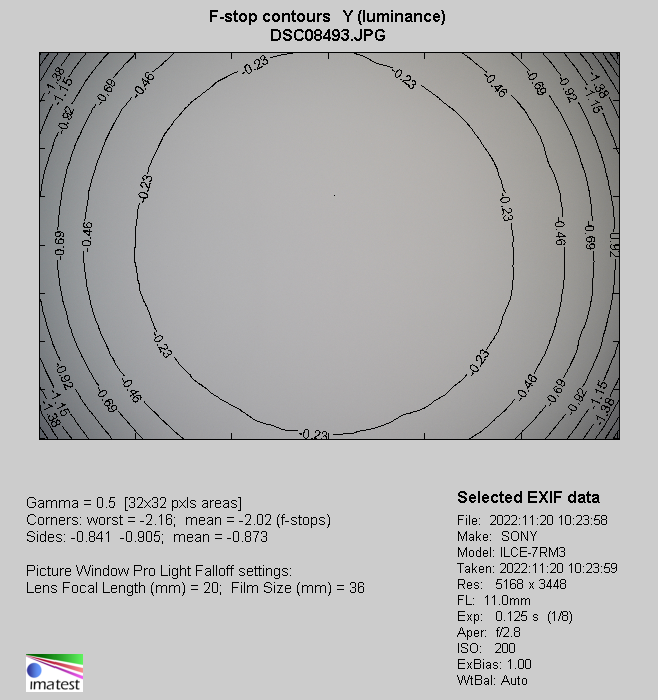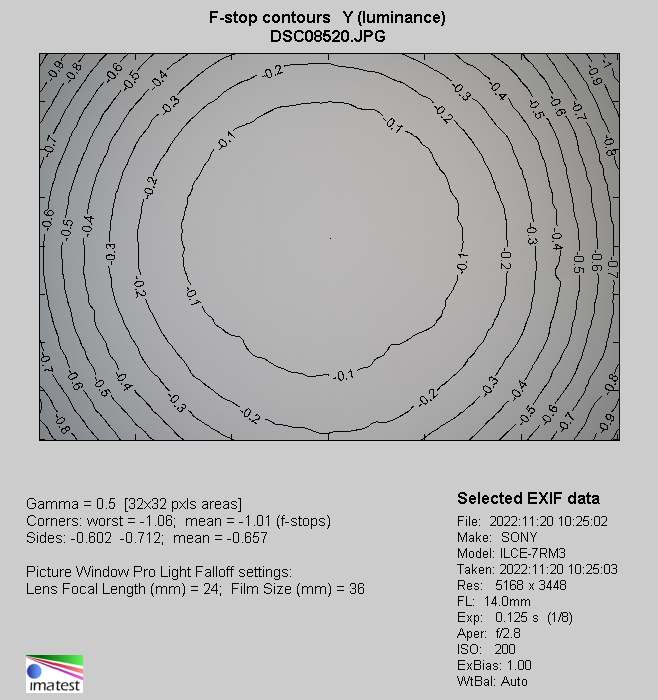Tokina ATX-M 11-18 mm f/2.8
8. Vignetting
| A7R III, FF, JPEG, 11ámm, f/11.0 | A7R III, FF, JPEG, 18ámm, f/11.0 |

|

|
And now let's check the performance of the lens attached to a camera with the sensor it is designed for – appropriate thumbnails you can find below.
Please Support UsIf you enjoy our reviews and articles, and you want us to continue our work please, support our website by donating through PayPal. The funds are going to be used for paying our editorial team, renting servers, and equipping our testing studio; only that way we will be able to continue providing you interesting content for free. |
- - - - - - - - - - - - - - - - - - - - - - - - - - - - - - - - - - - - - - - - - - - - - - - -
| A7R III, APS-C, JPEG, 11ámm, f/2.8 | A7R III, APS-C, JPEG, 11ámm, f/4.0 |

|

|
| A7R III, APS-C, JPEG, 14ámm, f/2.8 | A7R III, APS-C, JPEG, 14ámm, f/4.0 |

|

|
| A7R III, APS-C, JPEG, 18ámm, f/2.8 | A7R III, APS-C, JPEG, 18ámm, f/4.0 |

|

|
At the most difficult combination of 11 mm focal length and f/2.8 aperture vignetting amounts to 50% (−2.02 EV). It's a lot but, taking into account the fact that the bar is raised very high here, there is no reason to complain. By f/4.0 vignetting drops to 34% (−1.21 EV), and by f/5.6 to 25% (−0.83 EV). Further stopping down the aperture doesn't have any measureable influence on the aberration, described here.
At longer focal lengths vignetting is kept firmly in check. In case of 14 mm and the maximum relative aperture brightness loss in the frame corners amounts to 29% (−1.01 EV) and it decreases to 24% (−0.81 EV) on stopping down the lens to f/4.0. By f/5.6 you get a result of 22% (−0.73 EV), and it doesn't change in a noticeable way after further stopping down.
Very similar performance can be observed at the maximum focal length. By f/2.8 vignetting reaches again 29% (−0.99 EV), by f/4.0 it decreases to a value of 23% (−0.75 EV), and by f/5.6 we got a result of 20% (−0.65 EV) and it didn't change after a more significant stopping down.
Overall the performance of the Tokina in this category should be praised. Vignetting correction is not easy when it comes to a lens with such parameters; many producers have given up on correcting this aberration, assuming that it's something easy to adjust with the help of camera's software. They might be right but you have to pay for such a move with more visible noise. Personally I am very glad Tokina optics specialists have tried to correct vignetting this way.
| Sony A7R III, APS-C, 11ámm, JPEG, f/2.8 |
 |
| Sony A7R III, APS-C, 14ámm, JPEG, f/2.8 |
 |
| Sony A7R III, APS-C, 18ámm, JPEG, f/2.8 |
 |






